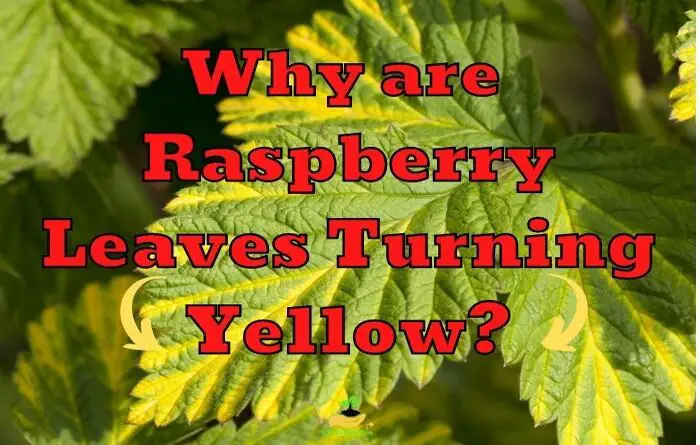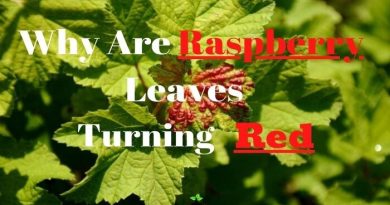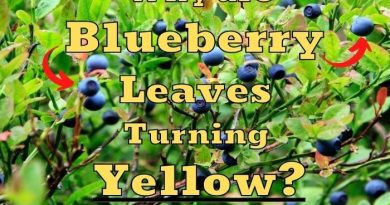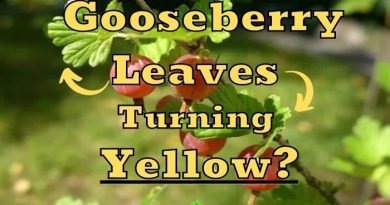[6 Reasons] Why Raspberry Leaves are Turning Yellow!
When growing raspberries, problems often arise. Raspberry leaves turning yellow is one of the common causes of concern for gardeners and an obvious sign that something is wrong with the plant and needs help.
Are wrong feedings, untimely watering, illiterate care, diseases or pests to blame? Let’s figure it out together.
The reasons why raspberry leaves suddenly begin to turn yellow are: a lack of nutrients in the soil, improper watering, diseases or pest infestation.
| Reasons Raspberry Leaves Turn Yellow |
|---|
| 1. Improper watering |
| 2. Nutrient deficiency |
| 3. High soil acidity |
| 4. Diseases |
| 5. Pests |
| 6. Natural aging |
1. Improper watering
Yellowing of raspberry leaves in spring and summer is caused by prolonged rainy weather, which leaches nutrients from the upper layers of the soil. The abundant moisture then prevents the roots from accessing these nutrients, resulting in a lack of nitrogen and potassium in the berry itself.
The gardener himself can also provoke this phenomenon by abundantly watering the raspberries with cold water and arranging an additional dangerous moisture stagnation at the roots.
When raspberries are well watered, they absorb more water than they need, which causes them to rot more easily and miss out on important nutrients.
Overwatering can also cause plants to get too much water at once, which makes them susceptible to diseases like root rot and fungal infections.
Raspberry leaves are turning yellow not only from an excess of moisture, but also due to drought when the plant simply does not have enough moisture and it slowly fades due to insufficient intake of nutrients.
In hot summer periods, it is necessary to water weekly, each time bringing 10-30 liters of water under the bush. To make moisture evaporate more slowly, it is recommended to mulch the soil with sawdust, straw or wood chips.
The leaves may also curl or become distorted in appearance if there’s not enough moisture in the soil. You should check the soil around your raspberries at least once a week and water them if it appears dry.
If you see leaves starting to turn yellow, check the soil around your raspberry plants for moisture. If it appears dry, add water immediately using a garden hose or watering can.
How to treat Improper watering
To restore their leaves color, it is necessary to provide raspberries with better watering with warm, settled water. It is best, of course, to take rainwater, but this is not necessary. The main thing is that it is clean, not cold and not hot.
Check the soil around your raspberries at least once a week and water them if it appears dry. Water deeply every two to three days, rather than sprinkling them lightly each day.
You should water your raspberries at least once a week, depending on how hot and dry it is outside. If you’re not sure whether or not your plants need water, check the soil around them. If it feels dry to touch, then you should give them a drink of water.
However, a fully grown raspberry bush can tolerate about 10 liters of water every two days in the dry midsummer.
Absolutely avoid water stagnation, which could cause, in a drastic and permanent way, damage and rot that form at the roots.
You can also add organic mulch around your plants as this will help retain moisture in their soil.
2. Nutrients deficiency
Low nutritional value of the soil meaning a lack of nutrients, is the second reason why raspberry leaves are turning yellow.
Raspberries are not particularly capricious. But on poor soils and in the absence of top dressing, the shrub begins to bear fruit worse, and turns yellow and sheds leaves.
It is not uncommon for raspberry leaves to turn yellow due to nitrogen deficiency. This element plays a major role in photosynthesis, so nitrogen starvation often causes blanching and yellowing of foliage.
In addition, the plant lags behind in growth and begins to bloom at the wrong time. This issue can be solved by introducing nitrogen fertilizing.
You can talk about nutrient deficiency if the plant turns yellow, but there are no traces of pests and fungal diseases on the leaves.
You can understand which nutrient raspberry lacks by its leaves appearance:
| Nutrient deficiency | Raspberry Symptoms |
|---|---|
| 1. Nitrogen | The leaves are small with a green to yellow color. |
| 2. Phosphorus | Yellowing moves from the lower leaves to the upper ones, from edge to tip. |
| 3. Zinc | Gray-yellow spots appear on the leaves, and then the greens begin to crumble. |
| 4. Iron | Leaves turn yellow, but bright streaks remain on them. |
| 5. Magnesium | The leaf begins to turn yellow from the center, and the edges dry and twist. |
| 6. Potassium | Yellow or dry border forms along the edge of the leaf. |
It also happens that the leaves turn yellow due to a lack of manganese or magnesium. This phenomenon can also be observed with an excess of phosphorus and potassium.
What steps need to be taken to resolve the issue? It is necessary to apply fertilizers, adhering to the established dosages and terms.
How to treat Nutrients deficiency
Organic fertilizers usually contain all the necessary elements, which is why they are considered the best for raspberries. This is chicken manure, humus.
With a deficiency of trace elements, it is necessary to supplement the nutrition of the curtain with appropriate complexes or individual preparations: magnesia, iron chelate, potassium permanganate, etc.
You can also fertilize your plants with a balanced fertilizer such as 10-10-10. Add compost and/or compost tea to your soil to improve its ability to hold on to nutrients.
You can correct the lack of nitrogen by providing the berries with regular watering and fertilizing with nitrogen fertilizers. For example, a solution of urea (150 g per 10 liters of water).
To cope with the lack of trace elements, it is necessary to apply complex fertilizers or feed raspberries with a specific substance.
3. High soil acidity
High acidity of the soil(low pH) is observed with excessive fertilization with various minerals. But raspberries do not tolerate high acidity and react with yellowing of the leaves. If this happens, you need to check the acidity of the soil.
This happens when the pH of the soil is too low and the plant cannot absorb these nutrients , which are essential for the production of chlorophyll. This pigment is essential for capturing sunlight and transforming carbon dioxide and water into sugars by which to feed ( photosynthesis ).
Raspberries turn yellow on the leaf in soils with excess nitrogen. If the soil on which the shrub grows is too acidic in composition, it is necessary to add 2 pounds (1kg) of wood ash or dry alkali metal like (sodium, potassium) per 1 square meter.
In most cases, the wrong pH of the soil is responsible for the lack of iron and magnesium. The nutrients are actually available, but the plant can no longer absorb them sufficiently.
How to treat High acidity of the soil
The normal indicator is 5.9-6.1. In case of increased acidity, dolomite flour or chalk (0.5 kg / 1 m²), slaked lime (400 g / 1 m²) should be applied to the soil.
After that, the ground under the raspberries is carefully dug up. This treatment helps to bring the acidity level of the soil closer to neutral.
Therefore, the pH value in the soil should be measured as a control. There are many test kits that are inexpensive and, in most cases, easy to use.
If the pH is above 6.5, it should be lowered to 5-6 with Epsom salt or rhododendron soil. The required amount of Epsom salt is always indicated on the packaging. Incorporating compost can’t hurt either.
4. Raspberry Leaves Turning Yellow due to Diseases
But, unfortunately, the reason that raspberries leaves turn yellow and wither can also be caused by viral or fungal diseases:
| Raspberry diseases | Description |
|---|---|
| 1. Raspberry chlorosis | Yellowing begins along the edge of the leaf, and then the entire leaf acquires this color. Severe yellowing of the upper leaves. |
| 2. Raspberry root gall cancer | The leaves turn yellow and even fall off. Berries become smaller, lose their taste. Poor shoot growth in the absence of signs of other diseases |
| 3. Raspberry rust | Pads with spores appear in a red color with a light shade. Small yellow spots are visible on the outer side of the leaf, which increase over time. |
| 4. Raspberry mosaic virus | Yellow spots on the leaves with thinning of the leaf plate. Slightly twisted leaves and poorly growing shoots. |
Raspberry chlorosis
Another terrible disease of raspberries is chlorosis. One of the symptoms that is key is the leaves turn yellow. First, yellowing begins along the edge of the leaf, and then the entire leaf acquires this color.
There are types of chlorosis that are caused by non-infectious causes (poor soil drainage, its high acidity and depleted composition), but most often the carriers of the disease are spider mites and aphids.
In the case of “normal” chlorosis, yellowing and wilting of leaves and shoots is caused by a lack of trace elements (iron) or lack of water. In the case of an infectious viral development of this disease, it is the activity of the Raspberry vein chlorosis virus.
The disease known as raspberry vein chlorosis is now a viral infection caused by raspberries aphids that affects many raspberries.
The symptoms of the disease begin with yellowing of raspberry leaves along the veins and end with the entire leaf wilting and dying, usually turning brown in color.
The disease causes all leaves on a raspberry bush to die and fall off, thereby exposing the plant to cold conditions during winter. The weakened raspberry is unable to survive and dies.
How to treat Raspberry chlorosis
In the treatment of non-viral raspberry chlorosis, the missing nutrients are introduced into the soil near the active zone of the root system, and foliar top dressing and injections of micro fertilizer solutions into branches and roots of raspberries are also used.
For quick improvement, you can take iron chelate, but this is a short-term solution.
It is wiser and in the long term to improve the soil: leave it covered with various mulches such as dead leaves, straw, amend it with manure or compost, add a draining material (sand, gravel).
In case of raspberry vein chlorosis is easier to prevent than to fight it:
- Choosing resistant varieties of raspberries is another way to reduce the risk of chlorosis.
- Purchase healthy seedlings from trusted manufacturers.
- Clear the area of weeds and litter to create an open space for plants to grow.
- Regularly disinfect garden tools with a solution of water, bleach and vinegar.
- Feed healthy plants humus, peat and compost once every two to three years at a rate of five to six kilograms per square meter (or one cubic yard) of garden space.
- Remove aphids using home-made remedies like soap and baking soda, tobacco mixture or ash infusion.
- Remove affected leaves and shoots, uproot heavily infected bushes, and burn them to prevent the spread of the disease.
Raspberry Root Gall
Raspberry Root cancer (root gall goiter) is a bacterial disease of raspberries that affects its root system. Bacteria penetrate into plant tissues through mechanical damage and form galls with a brown smooth coating on the roots, which then collapse.
Modified roots cease to fully absorb moisture and nutrients from the soil. As a result, raspberry leaves turns yellow and withers, the leaves dry up and fall off, new shoots grow short and twist, the raspberries become smaller and lose their taste.
In the case of progression of the disease, raspberries may even die.
Raspberries, under the influence of the disease, cease to receive a sufficient amount of moisture and nutrients, turn yellow, develop worse and eventually die.
How to treat Raspberry root cancer
Check the root collar and roots of the raspberry bush for growths. If you find any evidence of disease on these parts of your plant, dig up those affected bushes and burn them away from the garden.
You can not completely cure the raspberries from this disease, you need to focus on preventive measures and maintaining the plant. Risk factors for plants in the case of root cancer are long-term cultivation of a crop in one area, alkalized poor soil, dry weather.
Follow these steps:
- To prevent root cancer, soil should be fertilized with phosphorus-potassium fertilizers.
- Dig up and burn affected raspberries bushes.
- Remove weeds regularly.
- Before planting, shed the soil with a 1 percent solution of copper sulfate (100 grams/10 liters of water).
- Soak the roots of seedlings for 5-10 minutes in copper sulfate solution before planting (rinse with water afterwards).
Raspberry Rust
Also called raspberry yellow rust is considered one of the most common diseases caused by a fungus called Phragmidium rubi-idaei. It makes the raspberry outer side of the leaf turn yellow, and a rusty appearance, with a decrease in yield.
Raspberry rust occurs at high humidity and high air temperatures.
Raspberries are also at risk for a fungal infection. The fact that the raspberry is unhealthy is evidenced by small light red pads, the contents of which are parasite spores.
Soon they burst and the disease spreads to other healthy crops. The bush is noticeably weakening, the quality of the crop is noticeably reduced, the plant is not able to survive the winter cold.
As a preventive measure, plant the raspberry bush in well-drained soil and leave space all around. Rust thrives in damp conditions.
How to treat Raspberry Rust
There is no need to control it with commercially available fungicides in the home garden, because these agents would only have a purely symptomatic effect anyway.
Effective and sustainable help against raspberry rust usually only promises the improvement or optimization of the site conditions. Nevertheless, affected parts of the plant should be removed to prevent further spread.
To prevent raspberry rust, use fungicides 3 times a season. Before bud break and before flowering, spray the leaves with a solution of Bordeaux liquid or potassium salt.
Before bud break, in the spring, spray raspberries with a 3% solution of Bordeaux mixture , 2% potassium salt or 4% ammonium sulfate solution (400 g of the drug per 10 liters of water).
Raspberry Mosaic Virus
If you see the leaves of your raspberry turn yellow in angular, irregular spots before it turns black in entire twigs, it may be mosaic, a virus transmitted by aphids. The leaves are also deformed, often rolled up on themselves.
The most important carrier of this disease is the large and small raspberry aphid, although other aphid species can also be involved. These include the green-spotted and striped potato aphid, the bright green blackberry aphid or the black bean aphid.
The harmful symptoms of this disease can easily be confused with those of spider mites or the raspberry leaf mite. The leaf blades of infested plants show a mosaic of yellow spots and speckles or spots. Light green to yellowish discolorations appear along the main veins.
Depending on the variety of raspberry, the symptoms of this disease vary in severity. Young raspberry tendrils are rarely affected. With sensitive varieties, the tendrils can be stunted in their growth and the annual growth can be lower from year to year.
The raspberry mosaic also affects the quantity and quality of the fruit. Significantly fewer fruits are formed, which also have a rather bland taste.
How to treat Raspberry Mosaic Virus
It is currently not possible to combat the mosaic virus directly with chemical agents. Only against the aphids, the root of all evil, we should proceed carefully with approved and beneficial measure in order to avoid the spread of this virus.
It is not enough to cut off diseased canes of affected plants close to the ground. The entire plants must be dug up and disposed of with household waste. Fallen leaves or other plant parts should also be removed completely.
In order to counteract an infestation in the future, you should look for aphid-resistant varieties and completely healthy seedlings when buying raspberries. New plantings in the immediate vicinity of contaminated areas should be avoided.
- Monitor and eliminate aphids during the spring by spraying a black soap treatment.
- Cut off the affected canes at ground level, burn them in an incinerator.
5. Raspberry Leaves Turning Yellow due to Pests
If you notice yellow leaves in the raspberry, we begin to suspect pests.
Aphids
The garden pest has a small size, but at the same time forms very large colonies. Raspberries can be affected by green, gray and black aphids. The latter varieties are easier to notice on the leaves of the shrub. Insects suck juice from young plates, as a result, the plant turns yellow and fades.
Green, gray, brown or black aphids settle on young leaves and shoots. They usually appear in large clusters in hot weather, accompanied by their “shepherds” – ants. In raspberries affected by aphids, the raspberries leaves begin to curl, then they turn yellow and dry.
How to treat Aphids
You can get rid of aphids with a home solution – in a bucket of water, you need to dilute 1 kg of ash powder and a crushed bar of laundry soap. Wormwood or onion infusions also help. Raspberry treatments with insecticides give a good effect.
A soapy or soapy-soda solution helps well against aphids. To prepare, take a liter of water and add 4-5 tablespoons of dish detergent, washing powder or liquid soap.
Shake until foam appears and spray the affected raspberry leaves. It is recommended to carry out “soapy” spraying on cloudy days to avoid burns on the leaves. By the way, a soapy solution is the best way to deal with aphids on houseplants.
Spider Mite
White to yellowish, sometimes reddish-brown spots or speckles on the raspberry leaves can be an indication of an infestation with spider mites. Under the influence of the pest, raspberries turn yellow, its foliage curls and fades.
In the case of a very severe infestation, the leaves are literally spun in by the fine webs. Young leaves yellow more and more, curl up, dry up and finally fall off.
High temperatures in summer can lead to a veritable explosion in the spider mite population on varieties with a long harvest period, such as autumn raspberries.
How to treat Spider Mites
In order to detect an infestation as early as possible, regular checks are useful in the period from before flowering to August.
To combat spider mites, insecticidal preparations of general action are used, as well as garlic infusion or a solution of wood ash.
The female spider mites hibernate in sheltered places near the ground or at the base of the rod. It is therefore advisable to remove fallen leaves and also mulch.
Excessive amounts of nitrogen should be avoided, as they make the plants too fat and thus increase susceptibility to infestation.
6. Natural aging
It is quite natural for old leaves to turn yellow and fall off during the vegetation period, and this is more common with raspberries than with other trees. Why? The dense growth of tall rods quickly leads to shading below.
As soon as the plant assumes that a leaf is no longer productive (i.e. produces more than it uses), it breaks down the chlorophyll and causes the leaf to die a natural death.
Old leaves first acquire a light green color, and then turn yellow. Cut them off so that the bush does not waste strength and nutrients. Most often, the leaves on the lower branches turn pale.
But if there are a lot of them, feed the raspberries with urea. In autumn, excess leaves should also be removed. Put on a mitten, hold the shoot in your hand and swipe it from bottom to top. Cut off the remaining leaves with secateurs and burn.
How to prevent yellow leaves on raspberries
The following prevention measures need to be taken into account:
- Do not plant young raspberry bushes in place of the old raspberry, as bacteria will remain in the depleted soil.
- Make sure that the lower leaves are lit by the sun.
- Choose strong varieties such as Apricot, Brilliant, Ember, and Giant Yellow.
- Treat the curtain with fungicides in spring and autumn.
- Trim the tops of young vines in June to encourage growth.
- All weeds that begin to actively develop in May and throughout the summer must be uprooted and burned.
- Do not use cold water for irrigation.
- Prevent drying or waterlogging of the soil.
- Make sure there is sufficient watering.
- Experienced gardeners recommend organizing drip irrigation.
- In May, feed the raspberries with nitrogen.
Conclusion
To properly care for a raspberry that ends up with yellow leaves, it is advisable to carefully observe the symptoms that have appeared. But what is above all recommended above all is to bring together the best growing conditions so that your raspberries do not get sick!
With high-quality, regular care for raspberries, the leaves should not turn yellow. The plant will develop normally, as expected, without delay. The harvest will ripen on time, and its quality will please even the pickiest gardener!
Frequently Asked Questions
How to prevent fungal diseases on raspberries?
As a preventive measure, you should look for resistant or less susceptible varieties when you buy them. In addition, ensure good ventilation between the individual plants and a sunny and airy location.
When watering, the leaves should not be poured and cutting tools should always be disinfected if they come into contact with diseased plants.
1. Make sure the plants have enough water.
2. Check the soil around your raspberries at least once a week and water them if it appears dry.
3. Provide adequate nutrients to ensure that the plants are getting what they need to stay healthy.
4. You can use compost or compost tea to give them an extra boost of nutrients.
All of the above causes of yellowing of leaves in raspberries must be treated in order for them to grow properly:
1) Improper planting is corrected by transplanting raspberries to neutral soil, to a place where it will be dry and warm, with sunlight falling on the bush.
2) Watering and fertilizing are carried out according to strictly allotted rules for a certain raspberry variety, which are clarified in advance as soon as there is an intention to plant raspberries.
3) To defeat ferric chlorosis is to use particular specific fertilizers that contain iron in chelated form.
4) Control the watering to prevent the leaves of your plants from turning yellow.




